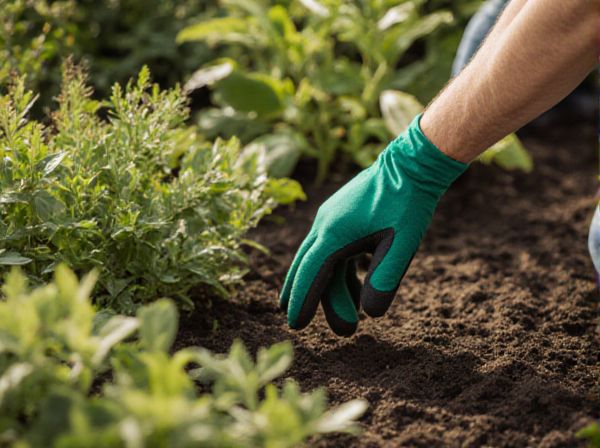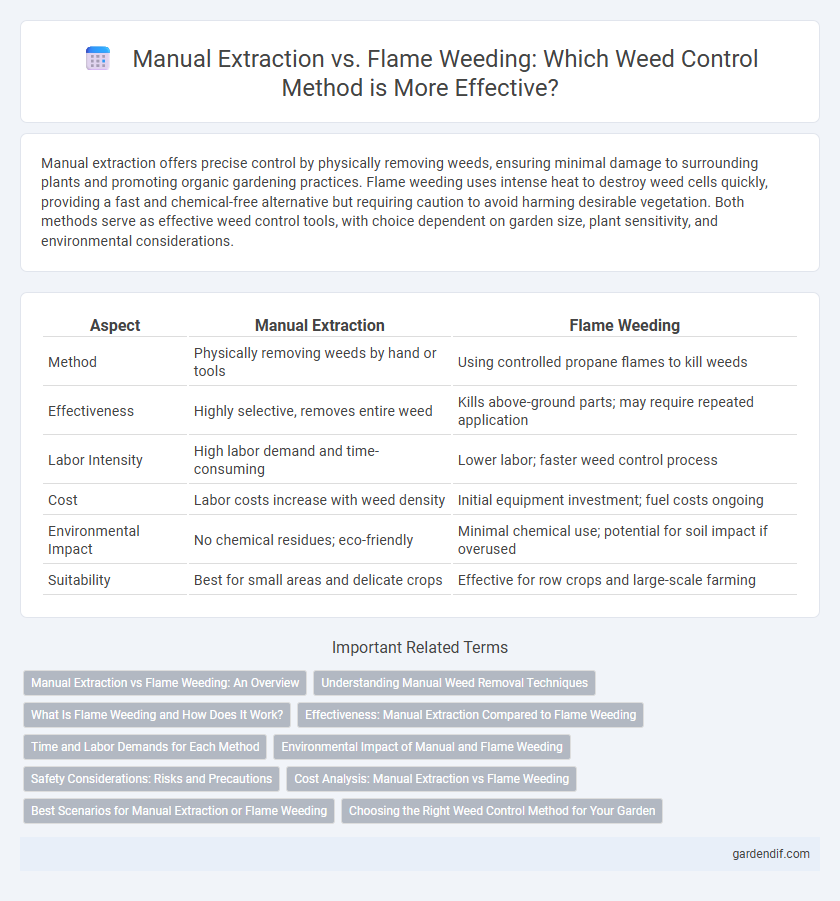
Manual Extraction vs Flame Weeding Illustration
Manual extraction offers precise control by physically removing weeds, ensuring minimal damage to surrounding plants and promoting organic gardening practices. Flame weeding uses intense heat to destroy weed cells quickly, providing a fast and chemical-free alternative but requiring caution to avoid harming desirable vegetation. Both methods serve as effective weed control tools, with choice dependent on garden size, plant sensitivity, and environmental considerations.
Table of Comparison
| Aspect | Manual Extraction | Flame Weeding |
|---|---|---|
| Method | Physically removing weeds by hand or tools | Using controlled propane flames to kill weeds |
| Effectiveness | Highly selective, removes entire weed | Kills above-ground parts; may require repeated application |
| Labor Intensity | High labor demand and time-consuming | Lower labor; faster weed control process |
| Cost | Labor costs increase with weed density | Initial equipment investment; fuel costs ongoing |
| Environmental Impact | No chemical residues; eco-friendly | Minimal chemical use; potential for soil impact if overused |
| Suitability | Best for small areas and delicate crops | Effective for row crops and large-scale farming |
Manual Extraction vs Flame Weeding: An Overview
Manual extraction involves physically removing weeds by hand or with tools, ensuring root systems are completely eliminated for long-term control. Flame weeding uses intense heat to damage weed cells and disrupt growth without disturbing soil structure or beneficial organisms. Comparing efficiency, manual extraction is labor-intensive but precise, while flame weeding offers rapid coverage and reduces chemical dependency.
Understanding Manual Weed Removal Techniques
Manual weed removal techniques involve physically uprooting weeds using hand tools such as hoes, trowels, or hand pulls, which allows for precise targeting of unwanted plants and minimizes soil disturbance. This method is labor-intensive but highly effective in small garden beds or areas where herbicide use is not desired. Comparing manual extraction to flame weeding, the former offers greater control over weed removal without the risk of heat damage to surrounding plants and soil microorganisms.
What Is Flame Weeding and How Does It Work?
Flame weeding uses intense heat from a propane-fueled flame to disrupt weed cell structures, causing them to wilt and die without chemicals. This method targets young weeds effectively by rapidly raising their surface temperature, leading to cell rupture and dehydration. Unlike manual extraction, flame weeding offers quicker treatment over large areas but requires careful application to avoid damaging crops and soil microorganisms.
Effectiveness: Manual Extraction Compared to Flame Weeding
Manual extraction offers precise control by directly removing weeds and their roots, reducing regrowth risks and ensuring thorough elimination. Flame weeding provides rapid, broad-spectrum control by using intense heat to damage weed tissue but may require multiple treatments to prevent regrowth. In terms of effectiveness, manual extraction is ideal for targeted weed management in sensitive areas, while flame weeding suits larger, less delicate fields with lower labor intensity.
Time and Labor Demands for Each Method
Manual extraction requires intensive labor and significant time, especially in large-scale weed management, as workers must carefully uproot each weed to prevent regrowth. Flame weeding offers faster coverage, reducing labor demands by using targeted heat to kill weeds, but may require repeated treatment for persistent species. Both methods balance time and labor costs differently, with manual extraction favoring precision and flame weeding emphasizing speed and scalability.
Environmental Impact of Manual and Flame Weeding
Manual extraction of weeds minimizes environmental harm by avoiding chemical runoff and soil disturbance, preserving soil health and biodiversity. Flame weeding emits greenhouse gases and poses a risk of unintentional fires, but it reduces herbicide use and chemical residues in the ecosystem. Evaluating these methods involves balancing carbon emissions against chemical pollution and habitat impact.
Safety Considerations: Risks and Precautions
Manual extraction of weeds minimizes exposure to harmful chemicals but requires proper protective gear to prevent cuts, infections, and repetitive strain injuries. Flame weeding involves using open flames, posing fire hazards and respiratory risks from smoke inhalation, necessitating the use of flame-resistant clothing and well-ventilated areas. Both methods demand adherence to safety protocols such as wearing gloves, eye protection, and ensuring safe handling to reduce accidents and health risks.
Cost Analysis: Manual Extraction vs Flame Weeding
Manual extraction of weeds demands significant labor costs and time investment, often increasing overall operational expenses in large-scale agriculture. Flame weeding requires upfront equipment costs but reduces ongoing labor expenses, offering a more cost-efficient solution in extensive or repetitive weed control scenarios. Evaluating long-term budgets reveals flame weeding as a more scalable and economical approach compared to the repetitive labor intensity of manual extraction.
Best Scenarios for Manual Extraction or Flame Weeding
Manual extraction is most effective in small gardens or areas with delicate plants where precision is required to avoid damage. Flame weeding excels in large, open fields with hardy weed species, providing rapid control without soil disturbance. Choosing between methods depends on weed type, area size, and crop sensitivity, optimizing weed management efficiency.
Choosing the Right Weed Control Method for Your Garden
Manual extraction offers precise weed removal by targeting roots directly, making it ideal for small gardens and delicate plants. Flame weeding uses intense heat to destroy weed tissue quickly and is effective for large areas with young, shallow-rooted weeds. Selecting the right method depends on garden size, weed type, and plant sensitivity to ensure sustainable and efficient weed control.
Manual Extraction vs Flame Weeding Infographic

 gardendif.com
gardendif.com